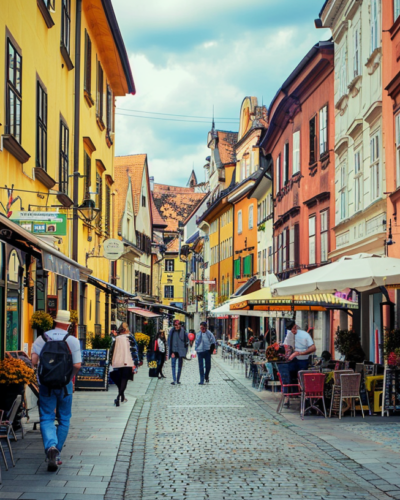Imagine stepping into a dimly lit hall, the air buzzing with anticipation, as you’re about to witness a marvel that would forever change entertainment. But this isn’t just any venue; it’s Berlin’s cinematic legacy where the first act caught on film opened its doors into a cultural phenomenon.

With their expansive screens and immersive audio, today’s movie theaters owe their success to origins in simpler times and places. Take the historic Vitascope Hall in New Orleans, for example. Opened in 1896, it’s often hailed as the inaugural permanent cinema, setting a foundational standard for the film industry.
However, the tale of the earliest nickelodeon intertwines with Berlin’s own cinematic evolution, where a modest theater ignited a cultural shift in an already artistically rich city. This Berlin establishment, though not the first ever recorded to feature film, significantly influenced the growth of cinema as an international leisure activity, which is now a thriving industry that bridges stories across global divides.
Exploring these foundational sites reveals stories of innovation, community, and the lasting impact of cinema. With Berlin‘s early theaters playing a central role, the transition from the silent, black-and-white films of yesteryear to today’s state-of-the-art digital screenings epitomizes the technological leap in filmmaking.
Delving more into Berlin’s cinematic heritage, we not only highlight key innovations but also underscore the timeless appeal of shared storytelling, highlighting global cinema’s capacity to unite diverse peoples through the universal language of film.
The Birthplace of Berlin Cinema: A Groundbreaking Venue
In the vibrant heart of Berlin— a city celebrated for its rich cultural mosaic, stands a landmark that heralded the dawn of serious cinema. The Central Hotel‘s Varieté Wintergarten was truly an iconic venue. It was once a hub of pioneering spirit that eventually played a pivotal role in shaping the entertainment landscape through Max and Emil Skladanowsky ‘moving pictures,’ for the eyes of 1895.
Today, as one wanders through Berlin, the resonance of those initial cinematic moments can still be felt, a testament to a legacy that continues to enchant cinephiles and wanderlust seekers. Other landmarks like the Babylon Kino serve as windows into this illustrious past, offering a taste of the magic that once captivated audiences in the same streets.
Yet, it’s important to note that the cradle of German cinema extends beyond Berlin’s city limits to the historic Babelsberg Studio in Potsdam-Babelsberg. Recognized as the world’s oldest large-scale film studio, Babelsberg has been at the heart of Germany’s film production, significantly contributing to the spread of cinema globally.
But while Berlin emerged as a vital hub for Germany’s burgeoning film scene in the early 20th century, even hosting the largest film festival globally, the genesis of German cinema is rooted in the Babelsberg Studio. This distinction enriches Berlin’s cinematic narrative, highlighting a broader landscape where innovation in film began and flourished.

From Silent Films to Blockbusters: The Evolution of Motion Picture Appreciation
As we trace the evolution of films on the silver screen, from its humble beginnings in Berlin to the global phenomenon it is today, we uncover a story of technological marvels and shared human experiences.
The transition from silent films to the immersive blockbusters of the digital age illustrates not just a change in sensory technology but in how we connect with stories and each other. Across the world, from the neon lights of Tokyo’s Shinjuku district to the historic cinemas of Paris’ Latin Quarter, the way we watch films continues to evolve, yet the essence of cinema, sparked in Berlin, remains unchanged.
The journey from silent, black-and-white shorts to today’s digital features underscores a dramatic transformation in storytelling and audience engagement. This evolution reflects broader cultural shifts and technological advancements, with each era’s films encapsulating the zeitgeist and pushing the boundaries of what cinema can achieve both technically and artistically.
Innovations Behind the Curtain: Technology That Shaped Cinema
The inception of the movie theater in Berlin was just the beginning of a journey marked by relentless innovation. From the introduction of sound and color to the advent of digital projection and 3D technology, each leap forward has expanded the boundaries of storytelling.
Further exploring the technological landmarks that have shaped cinema, such as the iconic Grauman’s Chinese Theater in Hollywood, offers us a fascinating insight into the industry’s continuing evolution. These venues, much like Berlin’s first theater, stand as testaments to human ingenuity and the endless pursuit of more profound, more engaging cinematic experiences.
Each technological leap in cinema, from the introduction of synchronized sound to turning gray into multicolored marvels, to today’s digital revolution— has expanded the canvas of storytelling, allowing filmmakers to craft more intricate, immersive worlds.
Such innovations, many of which were embraced and refined within the walls of pioneering theaters, have continually reshaped the viewer’s experience, making each film a unique journey into new realms of imagination.

Cultural Reels: How Berlin’s Theater Changed Entertainment Forever
The Berlin Wintergarten theater, established in 1887, holds the distinction of being Berlin’s earliest movie theater, where the Skladanowsky brothers unveiled the first short film presentation in 1895, pioneering the first Bioscop cinema.
This landmark event marked the advent of film projection, embedding the Wintergarten theater in cinema history not just as a variety theater but as a seminal venue for early film exhibitions, thereby enriching Berlin’s cinematic heritage.
While the Wintergarten theater‘s role in cinema’s evolution is undeniable, interpreting it as the catalyst for a global democratization of storytelling and a creator of shared cultural consciousness might extend beyond historical consensus. The theater’s contribution to cinema’s emergence is significant, yet the extent of its global influence on cinema as a communal experience remains a subject of interpretation.
Acknowledging Wintergarten‘s place in history is crucial, but it’s important to navigate the narrative of its worldwide impact with an understanding of the broader context of cinema’s evolution.
Preserving the Magic: The Legacy and Future of Movie Theaters
As we look to the future, the question of how to preserve the magic of movie theaters in the digital age looms large. The legacy of Berlin’s first movie theater serves as a reminder of the irreplaceable value of communal viewing experiences.
Initiatives to restore and repurpose historic theaters, such as the Alamo Drafthouse‘s mission in the United States, highlight a global effort to keep the spirit of traditional cinema alive. These endeavors not only preserve architectural and cultural heritage but also reaffirm the importance of movie theaters as places of community, creativity, and shared human experiences.
In an era dominated by streaming services and personal devices, the enduring appeal of the movie theater experience— a communal journey into storytelling, remains a testament to the visionary origins of Berlin’s first cinema. Efforts to preserve and revitalize historic theaters around the world not only honor this legacy but also reaffirm the unique magic of cinema that transcends the convenience of digital consumption, nurturing a communal spirit that is more necessary today than ever before.

Cinema’s Enduring Legacy: A Journey from Berlin to the World
Reflecting on the journey from Berlin’s first movie theater to today’s global cinematic landscape reconnects us to the essence of cinema as a shared human experience. This story, beginning with a single venue in Berlin, encapsulates the evolution of film from a novel entertainment form to a cornerstone of cultural and social life worldwide.
As we honor this legacy, join thiscityknows.com in its continued support to cherish movie theaters as the irreplaceable venues of community, creativity, and collective imagination they are.
Join us in celebrating the rich history and vibrant future of cinema by experiencing your next film in the magical ambiance of a movie theater!









